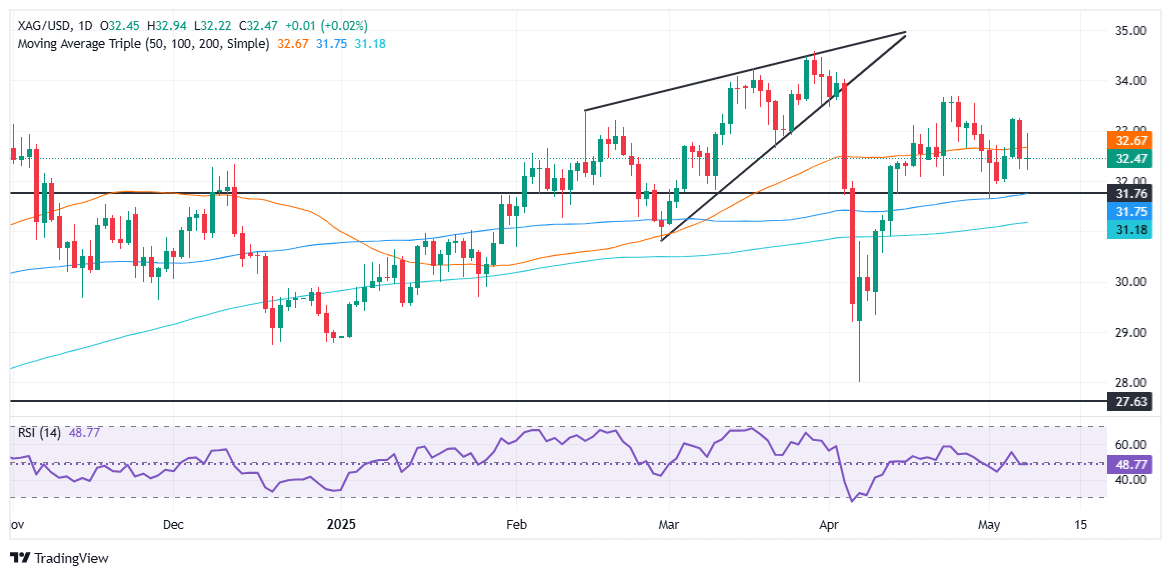Silver Price Forecast: XAG/USD steady above $32 as risk sentiment improves on US-China talks
- Silver capped by 50-day SMA at $32.68 despite intraday high of $32.93; RSI turns flat near neutral.
- Break above $33.00 could open path to $33.68 and $34.00; downside risk below $32.22 targets $31.80 and $31.19.
- Market sentiment buoyed by US-UK trade deal and hopes of de-escalation in US-China relations ahead of weekend talks.
Siver price held firm on Thursday as risk appetite improved on news of a US-UK trade deal, along with hopes that Sino-US tensions could be lowered, as delegations of both countries would meet in Switzerland this weekend. At the time of writing, XAG/USD trades at $32.44, down 0.15%.
XAG/USD Price Forecast: Technical outlook
Silver price is trading below the 50-day Simple Moving Average (SMA) at $32.68, a key technical resistance level that capped the metal’s advance despite hitting a daily high of $32.93. Momentum shows the lack of commitments of buyers and sellers as portrayed by the Relative Strength Index (RSI), which hovers near its 50 neutral line, turning flat. That said, XAG/USD would likely remain sideways in the short term.
For a bullish continuation, XAG/USD must clear the 50-day SMA and the $33.00 figure. Once achieved, the next ceiling level will be an April 25 daily high at $33.68, followed by $34.00. Conversely, if Silver slides beneath $32.22, look for a test of the 100-day SMA at $31.80, ahead of the 200-day SMA at $31.19.
XAG/USD Price Chart – Daily

Silver FAQs
Silver is a precious metal highly traded among investors. It has been historically used as a store of value and a medium of exchange. Although less popular than Gold, traders may turn to Silver to diversify their investment portfolio, for its intrinsic value or as a potential hedge during high-inflation periods. Investors can buy physical Silver, in coins or in bars, or trade it through vehicles such as Exchange Traded Funds, which track its price on international markets.
Silver prices can move due to a wide range of factors. Geopolitical instability or fears of a deep recession can make Silver price escalate due to its safe-haven status, although to a lesser extent than Gold's. As a yieldless asset, Silver tends to rise with lower interest rates. Its moves also depend on how the US Dollar (USD) behaves as the asset is priced in dollars (XAG/USD). A strong Dollar tends to keep the price of Silver at bay, whereas a weaker Dollar is likely to propel prices up. Other factors such as investment demand, mining supply – Silver is much more abundant than Gold – and recycling rates can also affect prices.
Silver is widely used in industry, particularly in sectors such as electronics or solar energy, as it has one of the highest electric conductivity of all metals – more than Copper and Gold. A surge in demand can increase prices, while a decline tends to lower them. Dynamics in the US, Chinese and Indian economies can also contribute to price swings: for the US and particularly China, their big industrial sectors use Silver in various processes; in India, consumers’ demand for the precious metal for jewellery also plays a key role in setting prices.
Silver prices tend to follow Gold's moves. When Gold prices rise, Silver typically follows suit, as their status as safe-haven assets is similar. The Gold/Silver ratio, which shows the number of ounces of Silver needed to equal the value of one ounce of Gold, may help to determine the relative valuation between both metals. Some investors may consider a high ratio as an indicator that Silver is undervalued, or Gold is overvalued. On the contrary, a low ratio might suggest that Gold is undervalued relative to Silver.

